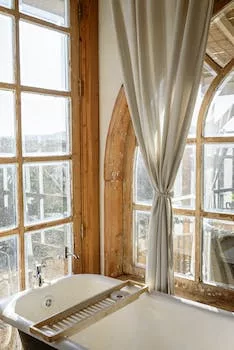Adapting Home Design for Aging in Place: Key Architectural Considerations
The role of architecture in creating a home that’s perfect for aging in place cannot be overstated. As the population ages, more and more people are looking to stay in their homes for as long as possible, rather than moving to assisted living facilities or nursing homes. This desire for independence and familiarity has led to a growing interest in designing homes that can accommodate the changing needs of individuals as they age. In this context, architects play a crucial role in ensuring that homes are not only aesthetically pleasing but also functional and adaptable to the evolving requirements of their occupants.
One of the key architectural considerations when designing a home for aging in place is accessibility. This involves creating spaces that are easy to navigate and barrier-free, allowing for smooth movement throughout the home. Doorways should be wide enough to accommodate wheelchairs or walkers, and hallways should be free of obstructions. Additionally, the installation of ramps or lifts may be necessary to ensure that all areas of the home are easily accessible, particularly if there are multiple levels.
Another important aspect of designing a home for aging in place is the incorporation of universal design principles. Universal design is an approach to creating environments that are usable by all people, regardless of their age, size, or ability. This can include features such as lever-style door handles, which are easier to operate than traditional knobs, and rocker-style light switches that can be operated with a simple push, rather than a pinch or twist motion. The use of non-slip flooring materials and the installation of grab bars in bathrooms can also contribute to a safer and more comfortable living environment.
In addition to accessibility and universal design, architects must also consider the adaptability of the home as the occupants’ needs change over time. This may involve designing spaces that can be easily modified or repurposed as needed. For example, a home office could be converted into a bedroom if the need for a main-floor sleeping space arises, or a large bathroom could be designed with the potential to accommodate a roll-in shower or a walk-in tub in the future. By planning for these potential changes during the design phase, homeowners can save time and money on costly renovations down the road.
Lighting is another crucial element in creating a home that is suitable for aging in place. As people age, their eyesight often declines, making it more difficult to see in low-light conditions. Architects should ensure that there is ample natural light in the home, as well as sufficient artificial lighting to create a comfortable and safe living environment. This may involve the strategic placement of windows and skylights, as well as the incorporation of energy-efficient LED lighting throughout the home.
Finally, architects must consider the overall layout and flow of the home when designing for aging in place. Open-concept floor plans can be beneficial, as they allow for greater flexibility in furniture placement and can make it easier for individuals with mobility challenges to navigate the space. Additionally, the placement of essential rooms, such as the bedroom, bathroom, and kitchen, should be carefully considered to minimize the need for excessive movement throughout the home.
In conclusion, the role of architecture in creating a home that is perfect for aging in place is multifaceted and complex. By considering factors such as accessibility, universal design, adaptability, lighting, and layout, architects can help to create homes that are not only beautiful but also functional and adaptable to the changing needs of their occupants. As the population continues to age, the demand for homes that can accommodate the unique requirements of older individuals will only continue to grow, making the role of architecture in this process more important than ever.
The Importance of Universal Design in Creating Age-Friendly Homes

The role of architecture in creating a home that’s perfect for aging in place cannot be overstated. As the global population continues to age, there is an increasing need for homes that are designed to accommodate the unique needs of older adults. This is where the concept of universal design comes into play. Universal design is an architectural approach that aims to create environments that are accessible and usable by all people, regardless of their age, size, or ability. By incorporating universal design principles into the planning and construction of homes, architects can help ensure that older adults can continue to live independently and comfortably in their own homes for as long as possible.
One of the key principles of universal design is flexibility. A home that is designed with flexibility in mind can easily be adapted to meet the changing needs of its occupants as they age. For example, a flexible floor plan might include features such as wide doorways and hallways, which can accommodate wheelchairs and walkers if needed. Similarly, adjustable countertops and cabinets can be raised or lowered to suit the needs of individuals with varying levels of mobility.
Another important aspect of universal design is simplicity. Homes that are designed with simplicity in mind are not only easier to navigate for older adults, but they also tend to be more energy-efficient and require less maintenance. This can be particularly beneficial for older adults who may have limited physical abilities or who may be living on a fixed income. Simple design elements, such as easy-to-use door handles and faucets, can make a significant difference in the overall usability of a home for an aging population.
Safety is also a critical consideration when designing a home for aging in place. Falls are a leading cause of injury among older adults, so it’s essential to incorporate features that can help prevent accidents. This might include installing grab bars in bathrooms, ensuring that flooring materials are slip-resistant, and incorporating adequate lighting throughout the home. Additionally, the inclusion of smart home technology, such as automated lighting and security systems, can further enhance the safety and security of a home for older adults.
In addition to these practical considerations, it’s also important to think about the psychological and emotional aspects of aging in place. A well-designed home should not only be functional but should also promote a sense of well-being and comfort for its occupants. This can be achieved through the thoughtful use of color, lighting, and materials, as well as by incorporating elements of nature and biophilic design principles. For example, large windows that provide ample natural light and views of the outdoors can help create a more uplifting and positive living environment.
Finally, it’s essential to consider the role of community and social connections in promoting successful aging in place. A home that is designed with this in mind might be located within walking distance of essential amenities, such as grocery stores, pharmacies, and healthcare facilities. Additionally, the inclusion of communal spaces, such as shared gardens or courtyards, can help foster a sense of community and encourage social interaction among neighbors.
In conclusion, the role of architecture in creating a home that’s perfect for aging in place is multifaceted and complex. By incorporating universal design principles and considering the physical, psychological, and social needs of older adults, architects can help create homes that are not only functional and safe but also promote a sense of well-being and belonging. As the global population continues to age, it’s more important than ever to prioritize the design of age-friendly homes that can support the independence and quality of life of older adults for years to come.
Innovative Architectural Solutions for Senior-Friendly Living Spaces
The role of architecture in creating a home that’s perfect for aging in place cannot be overstated. As the global population continues to age, there is an increasing need for innovative architectural solutions that cater to the unique needs of seniors. These solutions must not only provide a comfortable and safe living environment but also promote independence and social interaction. In this article, we will explore some of the key architectural features that can help create senior-friendly living spaces, allowing older adults to age in place gracefully and with dignity.
One of the most critical aspects of designing a home for aging in place is ensuring that it is accessible and easy to navigate. This means that the layout of the house should be simple and straightforward, with minimal obstacles and barriers. Wide doorways and hallways, for example, can accommodate wheelchairs and walkers, while open floor plans can make it easier for seniors to move around the house without feeling confined. Additionally, incorporating ramps or stairlifts in place of stairs can help seniors with mobility issues maintain their independence and access all areas of their home.
Another essential consideration in designing a senior-friendly living space is safety. Falls are a leading cause of injury among older adults, so architects must take steps to minimize the risk of accidents. This can be achieved by incorporating non-slip flooring materials, such as textured tiles or rubber mats, in areas prone to wetness, like bathrooms and kitchens. Installing grab bars in strategic locations, such as near the toilet and in the shower, can also provide seniors with additional support and stability. Furthermore, adequate lighting throughout the home can help prevent falls by ensuring that seniors can see clearly and navigate their surroundings with ease.
Comfort is also a crucial factor in creating a home that is suitable for aging in place. As seniors often spend a significant amount of time at home, it is essential to design spaces that are comfortable and inviting. This can be achieved by incorporating elements such as ample natural light, which has been shown to improve mood and overall well-being. Additionally, using materials that are easy to clean and maintain can help seniors keep their living spaces tidy and hygienic with minimal effort.
In addition to physical comfort, architects must also consider the emotional well-being of seniors when designing living spaces for aging in place. Social isolation is a significant concern among older adults, so it is essential to create spaces that encourage interaction and engagement with others. This can be achieved by incorporating communal areas, such as shared gardens or courtyards, where seniors can gather and socialize. Additionally, designing homes that are located close to community centers, parks, and other amenities can help seniors stay connected to their local community and maintain an active social life.
Lastly, it is essential to consider the adaptability of the living space as seniors’ needs change over time. This can be achieved by incorporating universal design principles, which focus on creating spaces that can be easily modified to accommodate different needs and abilities. For example, installing adjustable countertops and cabinets in the kitchen can allow seniors to continue cooking and preparing meals even if their mobility becomes limited.
In conclusion, the role of architecture in creating a home that’s perfect for aging in place is multifaceted and complex. By considering factors such as accessibility, safety, comfort, social interaction, and adaptability, architects can design living spaces that not only meet the unique needs of seniors but also promote independence and dignity. As the global population continues to age, it is crucial that we continue to innovate and develop architectural solutions that cater to this growing demographic, ensuring that seniors can age in place gracefully and with the support they need.
Q&A
Question 1: What are the key architectural features to consider when designing a home for aging in place?
Answer 1: The key architectural features to consider when designing a home for aging in place include single-level living, wide doorways and hallways, open floor plans, accessible bathrooms with grab bars and curbless showers, slip-resistant flooring, ample lighting, and adaptable spaces that can accommodate future modifications or assistive devices.
Question 2: How can architects ensure that a home remains functional and comfortable for seniors as they age?
Answer 2: Architects can ensure a home remains functional and comfortable for seniors by incorporating universal design principles, which focus on creating spaces that are usable by people of all ages and abilities. This includes providing easy access to essential spaces, minimizing the need for stairs, and incorporating adjustable and adaptable features that can accommodate changing needs over time.
Question 3: What role does technology play in creating a home that’s perfect for aging in place?
Answer 3: Technology plays a significant role in creating a home that’s perfect for aging in place by enhancing safety, comfort, and convenience. This can include smart home systems for controlling lighting, temperature, and security, as well as assistive technologies such as voice-activated devices, remote monitoring systems, and telehealth services that support seniors in maintaining their independence and well-being.
Conclusion
In conclusion, the role of architecture in creating a home that is perfect for aging in place is crucial, as it ensures the design and layout of the house cater to the evolving needs of its occupants. By incorporating elements such as accessibility, adaptability, safety, and comfort, architecture can significantly contribute to enhancing the quality of life for seniors, allowing them to maintain their independence and well-being in a familiar environment.


